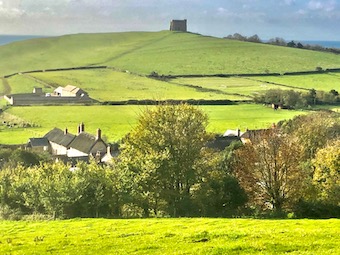First published in: The Times Click here to view a map for this walk in a new window





Facebook Link:

Mist was rolling high on the Dorset downs as we came down a steep green valley into Plush. The little collection of houses lay under mossy thatch along their lane. A few cheerful drinkers looked out of the windows at the Brace of Pheasants and shook their heads over the weather. ‘Going out walking? You won’t see a thing!’
In the chalky holloway that lifted us to the heights of Church Hill grew primroses and violets, bluebells and pink campion. All had burst out together last week at the first hint of spring warmth. Today the birds seemed subdued by the cold hand of the mist, but a blackcap suddenly produced a mellifluous solo among the oaks, short but sweet.
As we reached the gaunt old barn at the top of the climb a roe deer went bounding away, leaping high over crops and fences. We followed the rutted course of the Wessex Ridgeway, an ancient drove road running east-west along the nape of the hills. The old cottage at Folly was once a drover’s inn, where the hardy drovers in their felt hats, stocking feet soaped against blisters, would stop in for refreshment while their flocks cropped the wide verges of the ridgeway.
We passed through woods of oak and ash where bluebells made a hazy sky of the undergrowth, and dropped down a long flinty lane into Higher Melcombe. Lumps and bumps in the fields were all that remained of the medieval village deserted by its people after the Black Death deprived them of their feudal livings. But the handsome old manor house was still there, its chapel walls striped in stone and flint.
Blackbirds sang, and a tractor whined as it trimmed the first grass of the year. We climbed away up a hedge towards a wood, invisible in the hill mist, that roared softly and mightily, a sea-like cadence. Primroses and cowslips spattered the banks of the hollow lane, and among them a hybrid of the two plants raised its dark yellow multiform head on a slender talk.
We skirted the plunging slopes of Lyscombe Bottom, farmed with no pesticides or artificial fertilisers, and descended another deep-sunk old green road into Plush. ‘See anything?’ asked the regulars in the Brace of Pheasants. ‘No, not a thing,’ we replied.
Start: Brace of Pheasants Inn, Plush, Piddletrenthide, Dorset DT2 7RQ (OS ref ST714022)
Getting there: Plush is signposted from Piddletrenthide on B3143 (off A35 at Puddletown).
Walk (8 miles, trackways and farm paths, OS Explorer 117): From Brace of Pheasants, right along road; in 100m, right (‘Church Hill’ fingerpost/FP) up bridleway for 1 mile to Wessex Ridgeway/WR (707035). Right (east) along WR to cross road at Folly (728032). In 300m fork left uphill (733030, bridleway fingerpost/BFP); in 100m fork left (BFP). In 400m through gate, turn left (737028, BFP) across field.
Pass telephone pole, then breeze-block shed; ahead in same direction (WR) across field and through double gateway (740030, WR). Keep ahead; in 50m, fork right down grassy holloway, through gate into wood (741031). WR forks left, but keep ahead downhill (‘Higher Melcombe’) for ⅔ mile to road (751025). Right through Higher Melcombe.
In ¼ mile, just before Higher Melcombe Farm, left (747025, blue arrow/BA, FP in hedge) on track. In 70m, right (gate, BA) up field edge. In 250m through gate (745025, BA); left up hedge, then sunken lane. In 600m at top of rise, through gate; right on gravel track (742021, ‘Nettlecombe Tout’) with hedge on right. In 500m fork left (740025) across field to go through gate by Lyscombe Farm notice (739026).
Fork left away from fence, but keep it close on your right, following same contour across lumpy ground. In 900m at 4-finger post on right (730024), right through gate; left (‘Doles Ash Farm’) along hedge. In 300m at end of trees, left across fence (728021); right past trig pillar. On beside fence, then across field, for ½ mile to corner of triangular copse (721018). Bear right (WNW) across open field (perhaps through crops) for 300m to hedge gap with arrow (718019). Ahead to stile (717020); downhill to road (717022); left into Plush.
Lunch/Accommodation: Brace of Pheasants, Plush (01300-348357, braceofpheasants.co.uk) – cosy, friendly village inn.
Info: Dorchester TIC (01305-267992); visit-dorset.com; satmap.com; ramblers.org.uk
















































































